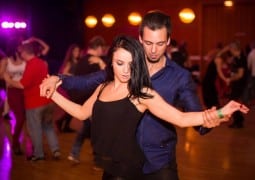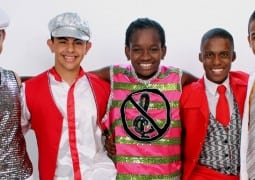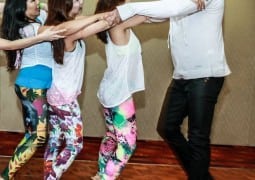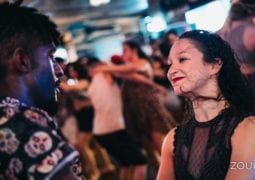“Jaime Says” – My Interview & Experience With Jaime Aroxa @ Dutch Zouk

The name, Jaime Aroxa may not be familiar to some YouTube surfers, nor is it currently seen partnered with a familiar dance diva, or in any of the latest popular Zouk video creations … yet Jaime Aroxa is mentioned in the bio of many of today’s most prominent Zouk instructors. Indeed, while doing research for my book “The Art & Sensuality of Brazilian Zouk Dancing,” I had frequently encountered his name and felt compelled to add him to the chronological history chart without fully realizing the impact he has had on the evolution of Brazilian Zouk today. Recently, Jaime made a new milestone with his passionate teaching at the first “Teacher Training Intensive” presented by the 5th Dutch International Zouk Congress. His name on the faculty convinced me that this would be a rare opportunity to see the various generations of Brazilian Zouk masters at work; passing their knowledge, experience, and wisdom to the next generation of International Zouk instructors. Indeed many of us had come from all over the world to further our own Zouk education.
Jaime Aroxa, a distinguished slender gentleman with grey hair (quite a rarity in the Zouk world but much appreciated by many like me), could easily pass for an elegant seasoned and graceful ballet master. Commanding a large room filled with students, he reveals himself, instead, as an effervescent Brazilian Zouk dance master, whose energy for the dance could not be contained with the more conventional reserved European ways. Even though his English is limited (yet beautifully translated by Brenda Carvalho – another one of his prized students now a sought-after Zouk dancer extraordinaire working with Xandy Liberato) you can almost guess what he wants to share simply by looking at this agile and expressive physicality; from his eyes to his core, from his gestures to his smile. Expression, simplicity, conversation are concepts that indeed seem to be continuously drilled as he shares his dance methodology with us.
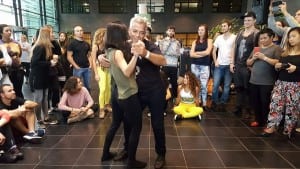
Jaime has a knack for simplifying every aspect of his teaching or dancing, contrary to some current teachers who try to reinvent the wheel or even complicate the dance unnecessarily. Jaime brings an engaging simplicity to his teaching in a uniquely endearing and heartwarming way, almost taking us back to Zouk kindergarten. Not in a condescending way, but in a way which aims to free dancers of the self-judgement, assumptions and expectations that afflict many students during the learning process. It seems that he does it because he wants to make sure everyone gets it, and “no one is left behind.” And that method does work!
During the first class I attended, he had us repeat him vocally and physically, almost like a “Simon Says game! And in a magical way he got everyone to do what he asks. He would put his hands on his throat, on his chest, on his core, on his circling pelvis and down to his legs and then stretched up to the stars, and we all followed along. He would ask us to put one hand on each glute, to emphasize the 2 separate body parts. With that gesture he reinforced the notion that each cheek needed to move separately when walking, dancing and eventually Zouking. In a flirtatious and exaggerated way he even showed us, bringing a roar of laughter to all. There is always a background giggle to his classes. But in the end, we all got it! That image of him clasping his butt cheeks and moving them separately as he was dancing is forever etched in my mind, and will only help stress the much needed hip movement in dancing Zouk.
The game is taken a step further when he starts singing and humming the classic Meu Anjo saxophone intr: “nanana nana nana nana nananana” and the class, hesitantly at first, instinctively responds with the next musical phrase:“nanana nana nana nana nananana” and he continues “nanana nana nana nana na naaa na” then everyone sings together “nanana nana nana nana nananana.” Did he unbeknownst to us all just show, teach and apply the concept of call-response-connection? Genius! He takes it further by adding the concept of creating good conversation. To avoid dull and boring conversations, he emphasizes the importance of being unpredictable; to surprise and be one with the music when dancing. Indeed music to Jaime is the third person in the dance. To him music allows the dancers to get lost in the unknown future of this tri-partnership, eventually reaching Zouk ecstasy!
I was lucky enough to steal Jaime away and sit down for a quick interview for Zoukology (with the help of Igor Fraga, NY instructor, translating for me). I wanted him to share more about his thoughts and wisdom with us to inspire the upcoming generation of Zouk instructors even more and refine our craft.
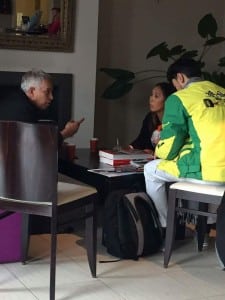
What are aspects of teaching you think are important to bring to Zouk class?
The teacher needs to have psychological abilities to understand that what is easy to him may not be easy for others. Teachers needs to open people to their full potential and offer guidance.
What would make an amazing dance? Who are your favorite dancers to dance with?
For me, a follow needs to know how to tease, be creative, surprise me, and not be afraid of the leads mouth, his eyes, his arms, and reciprocate, and have the music inside her. Brenda is one of my favorite people to dance with.
Where do you think Zouk is going to go in the next 5 or 10 years?
Teachers are getting better. They have access to so much now. But actually less is more in this case. Take Kizomba, for example. It is becoming more popular than Zouk. Kizomba can influence Zouk to come back to simplicity. Zouk is becoming only for the young, but if you make it a simple dance, you can pull more people in.
What are some weakness/strengths you observe in social dancing?
I like to use “ritual” as the word. Social… hmm, that is not really how you socialize… but you rather create a ritual together. Dance means different things from culture to culture. Some of the space is open, some it is closed. In China, one needs to open up the space to create a sense of freedom with the dance.
Congresses are optimistic but not always realistic. Students need to not only prepare to go to congresses, but their main focus should be on developing a sense of group setting where they can really grow. Schools need many students in order to make a group setting. The social media helps but one needs to develop a group feeling; an inclusive environment of good needs to spread. Zouk is a seed to free the body, and if that seed grows with others we can have a revolution.
In what ways were you surprised or not about the development or evolution of Zouk today?
It is not a surprise to me. I have been working in this space before and now. Even if I started in a different era, I influenced, continue to create and participate in the evolution of Zouk. I had dance labs and workshops with contact improv, musicality, connection – not only me, but for my teachers who I trained in Rio as well. Those workshops on contact improv of today… I was already doing them back then. It was around 1995 when the beginning of a transformation happened. My choreography started changing too and was revolutionary. I created a show titled “Lambada Alada” in 1990. It was a 1-hour show of Lambada mixed with Zouk. But it was more traditional – creating new steps for Lambada.
You were avant-garde in your vision for Zouk. Tell me more about the early 90s when Adilio and Renata were in your company.
Renata and Adilio trained and worked with me for 10 years. Then I personally went through a symbolic burial of Lambada which was very sad. Adilio and Renata continued to develop Zouk and took it to Europe and continued changing the Zouk. Many Lambada dancers got into Zouk. In 2000 great congresses started and that helped revive the dance.
One can easily conclude that Jaime Aroxa is a unique and knowledgeable Zouk master and educator who has led a successful dance academy in Rio for the last 25 years. He has total respect for all dances and his passion for Zouk to this day is palpable. His classes are a special mix of dance technique, creativity as well as his own particular positive philosophy on life. He hopes that dance becomes that special place where men respect women, women have no fear of men and bring that knowledge and attitude to everyday life. Something he feels strongly that we each should share with the world.
Later that week I was honored to dance with Jaime during one of the pre-parties. He is definitely as charming and down-to-earth on the dance floor as he is in class, where his main goal as a teacher is to encourage and help people to dance and keep coming back for more. As he mentioned at the teacher’s training; for him “there are two birthdays in a person’s life: the first when you are born and the second when you begin to dance”… I bet he is most interested in that 2nd birthday for all.
Tags AroxaBrendaDutchJaimeLambaLambadaMarieMeu AnjoRioTeachers TrainingZouk Lambada
About: Marie Alonzo Snyder
- Previous Video: Kamacho & Debby Demo @ the 2016 Dutch International Zouk Congress
- Next Video: Andrea & Silvia’s Sensual Bachata Performance @ the 3rd Boston Brazil Dance Festival
You may also like...
Sorry - Comments are closed



